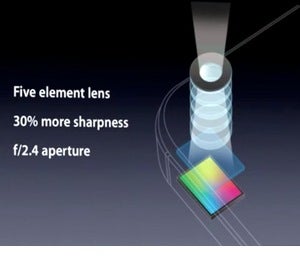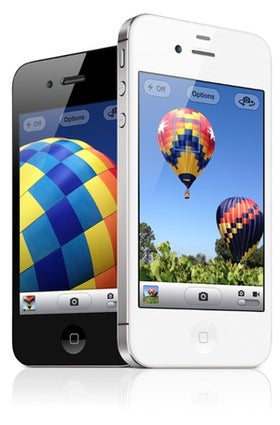The iPhone 4S - the technology behind its camera

Introduction
That the iPhone has become a widely popular substitute for those ubiquitous point-and-shoot cameras is an indisputable fact, as its impressive Flickr stats go to show. And the photographic glory of Apple's pride and joy is expected to reach new peaks in the near future thanks to the potent new camera that the iPhone 4S will come equipped with. 8-megapixel sensor, backside illumination, hybrid IR filter, F/2.4 aperture size, and a handful of other specs were touted at the smartphone’s unveiling. But in real life, how much of a difference all this technical mumbo jumbo is going to make?
We will now break down into bits all of the iPhone 4S' camera features and explain how they act together to make the photos that Apple's latest smartphone shoots look their best.
Resolution
Megapixels are the tiny dots that make up the image, and their number is usually what most consumers are interested in. As common sense would lead one to believe, the more pixels you have, the better an image is going to be. In this category, the 8-megapixel camera on the iPhone 4S should be an improvement over the 5-megapixel one found on its predecessor as it has 60% more pixels at its disposal. But in reality, pixel count does not automatically translate into quality images.

The optical system is the camera's “eye” and as such its quality is crucial. Of course, Apple is well aware of that fact, which is why the optics on the iPhone 4S have been improved. Five lenses working together is what guides the light towards the image sensor. In comparison, this is one more from what the camera on the iPhone 4 had, and according to Apple, the result is 30% sharper images than ever before seen on an iPhone.
Aperture
Guiding light is one thing, but letting it in is a different story. The wide F/2.4 aperture on the smartphone's camera allows for more light to hit the sensor for the same amount of exposure time, meaning that images can be captured at lower sensitivities and at higher shutter speeds. And while there are smartphones out there whose camera apertures go even wider, the F/2.4 figure is impressive nonetheless. The end result should be less digital noise, reduction in motion blur, and a boost in low-light performance when compared to previous iPhone models.

In a nutshell, that is a build process that arranges the elements within the sensor in a way that allows more light to be captured and transformed into digital information. On one hand, the iPhone 4 has a back-illuminated sensor as well so having the technology on the iPhone 4S’ camera isn’t anything groundbreaking. But on the other, Apple claims that the new iPhone’s sensor captures up to 73% more light than the one found in the previous model, so we might see some noticeable real life improvement after all.
Color accuracy
A so-called hybrid IR filter blocks away those pesky infrared rays allowing only visible light from entering the camera module. Now, Apple didn’t bother to describe what the “hybrid” part of the feature’s name stands for, but one possible explanation is that the IR filter both absorbs and reflects the unwanted infrared spectrum. With its help, the iPhone 4S' camera will supposedly achieve better color accuracy and uniformity across the entire image.
Last but not least, the A5 chip will also play a part in making those photos of yours look better. Apple claims that its built-in imaging signal processor can deliver up to 26% more accurate white balance when compared to the previous iPhone model. Since our first-hand experience with the iPhone 4 shows that its camera doesn't get along well with bright sunlight, we hope that both these new features will take care of the issue.
One more thing…
However, what the smartphone’s camera really outruns the competition with is its raw speed. Apple claims that the iPhone 4S needs only 1.1 seconds for its camera to boot, to focus on an object and to take a photo of it. In addition, 0.5 seconds are allegedly enough for the camera to capture the next image. These latency times are nothing but mind blowing, and if they turn out to be true out in the real world, the iPhone 4S would steal the “fastest camera on a phone” title from the Nokia N9.
Video performance
If a picture is worth a thousand words, a video should be worth a million. Apple’s latest smartphone can capture footage at 1080p HD resolution, which is pretty much as high as any modern handset can go. The higher resolution translates into sharper, more detailed videos, and the effect gets even more noticeable if you play them back on your flat-screen HDTV.
Another feature that helps making iPhone 4S videos look great is the temporal noise reduction. In plain words, the still areas of the frame get their noise levels averaged over time. There is a video demonstration of the technology on YouTube, so feel free to check it out by hitting this link.
Video image stabilization is a perk that you might be already familiar with, but it has to be mentioned nevertheless. Think of it as a way of reducing the effect your shaky hands have on the footage while it is being recorded, and the end result is smoother, eye-pleasing video.
What Apple skipped on
Although Apple equipped the iPhone 4S with one pimped out camera, the LED flash that it is backed up by appears to be untouched. That isn’t good news as the flash performance on the iPhone 4 was underwhelming, to say the least. Sure, some of the changes in the camera’s optical system might make a difference when shooting at night, but all the tweaks would be in vain if the final image gets spoiled by a blob of light that the LED flash is going to slap on it.
Conclusion

Nevertheless, we cannot wait until get our itchy hands on the iPhone 4S and throw it in the ring against some other smartphone heavyweights where its true photographic power will be revealed. And even if it doesn’t emerge victorious at the end of such a battle, it will surely give the competition a run for its money.
Follow us on Google News













Things that are NOT allowed:
To help keep our community safe and free from spam, we apply temporary limits to newly created accounts: